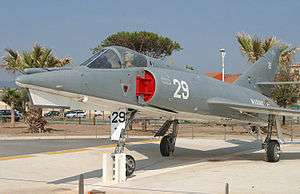Dassault Étendard IV
| Étendard IV | |
|---|---|
 | |
| Role | Strike fighter |
| National origin | France |
| Manufacturer | Dassault Aviation |
| First flight | 1958 |
| Introduction | 1962 |
| Retired | 1991 |
| Status | Some IVPs still in service |
| Primary user | French Navy |
| Number built | 90 |
| Variants | Dassault-Breguet Super Étendard |
The Dassault Étendard IV was a subsonic carrier-borne strike fighter aircraft, which entered service with the French Navy in 1962. It served as the basis for the more advanced Dassault-Breguet Super Étendard. During the 1970s, it had been intended to replace the Étendard IV with a navalised version of the SEPECAT Jaguar, designated as the Jaguar M. However, development of the Jaguar M was cancelled and shortly after replaced by the Super Étendard. The Étendard IV was progressively withdrawn during the 1980s and finally retired from service with its sole operator in 1991.
Development
The Étendard's history began with two different design requirements in the early 1950s for light fighters, one for the French Air Force and the other for NATO air forces. Dassault used the same basic design for both these specifications, designated as the Étendard II and Étendard VI respectively, neither of which received any orders. The company also developed a larger and more powerful variant, which was originally designated as the Mystère XXIV, simultaneously as a private venture.[1]
The French Navy showed interest in the more powerful aircraft, which led to Dassault constructing a prototype navalized version; this first prototype conducted its first flight on 24 July 1956.[2] Sufficiently satisfied with its performance, the French Navy procured 69 Étendard IVM fighters and 21 Étendard IVP reconnaissance versions. From 1962, these were being deployed aboard the service's newly built Clemenceau-class aircraft carriers, the Clemenceau and Foch.
The Jaguar M, a navalized variant of the Anglo-French SEPECAT Jaguar, was intended to be the Étendard's replacement, but this effort was derailed by political lobbying by Dassault, who favoured their own proposed upgraded version of the aircraft, which would later enter service as the Super Étendard.[2] The original Étendard was retired from carrier service in 1980, and was phased out from active roles in 1987.[2]
Design
The Étendard was a naval light attack fighter, which in service was often recognized for its popularity with its pilots due to its maneouverability.[2] It had a highly swept foldable wing, which featured double-slotted flaps and spoilers, as well as powered ailerons and leading edge droop flaps.[2] It was powered by the SNECMA Atar engine, which had also powered the French Air Force's Dassault Mirage III. The configuration was broadly similar with the exception of the removed afterburner. The Étendard was capable of transonic speeds, being only able to exceed the speed of sound when in a dive.[2]
The Étendard could be furnished with various equipment to carry out its mission roles, which included attack, photo-reconnaissance, and aerial refueling tanking. In addition to the commonly fitted 30mm DEFA cannon, various armaments and munitions could be carried on the four wing hardpoints, such as Nord 5103 air-to-air missiles, rocket pods, bombs, and drop tanks. A retractable nose-mounted refueling probe was also fitted. Other optional equipment included a Tacan receiver and a braking parachute for land operations. A compact Dassault Aida radar was installed in the nose, along with a small infrared sensor for guiding munitions.[2]
Variants
- Étendard IV
- The prototype powered by a 34.34 kN (7,720 lbf) SNECMA ATAR 101E3, first flown on 24 July 1956.[3]
- Étendard IVB
- One prototype fitted with a 49.82 kN (11,200 lbf) thrust Rolls-Royce Avon engine and blown flaps.
- Étendard IVM
- Single-seat Maritime strike fighter aircraft for the French Navy.
- Étendard IVP
- Single-seat Photo reconnaissance aircraft for the French Navy.
Operators
Specifications (Dassault Étendard IVM)
General characteristics
- Crew: one
- Length: 14.40 m (47 ft 3 in)
- Wingspan: 9.60 m (31 ft 6 in)
- Height: 3.79 m (12 ft 6 in)
- Wing area: 29 m² (312 ft²)
- Empty weight: 5,900 kg (13,000 lb)
- Loaded weight: 8,170 kg (18,010 lb)
- Max. takeoff weight: 10,200 kg (22,500 lb)
- Powerplant: one × SNECMA Atar 8B turbojet, 43.16 kN (9,703 lbf) each
Performance
- Maximum speed: 1,099 km/h (593 knots, 683 mph)
- Range: 3,300 km (1,800 NM, 2,100 mi)
- Service ceiling: 15,500 m (50,900 ft)
- Rate of climb: 100 m/s (19,700 ft/min)
- Wing loading: 282 kg/m² (57 lb/ft²)
- Thrust/weight: 0.54
Armament
- Guns: 2 × 30 mm (1.18 in) DEFA 552 cannons with 150 rounds per gun
- Rockets: 2 × Matra rocket pods with 18× SNEB 68 mm rockets each
- Bombs: 1,360 kg (3,000 lb) of payload on four external hardpoints, including a variety of bombs or Drop tanks
See also
- Related development
- Aircraft of comparable role, configuration and era
- Related lists
Squadrons
References
- Notes
- ↑ "Military Dassault aircraft". Dassault. Retrieved 27 November 2012.
- 1 2 3 4 5 6 7 Gunston and Gilchrist 1993, p. 169.
- ↑ Kay, Anthony L. (2007). Turbojet: History and Development 1930–1960: Volume 2: USSR, USA, Japan, France, Canada, Sweden, Switzerland, Italy, Czechoslovakia and Hungary. Marlborough, Wiltshire: Crowood Press. ISBN 978-1-86126-939-3.
- Bibliography
- Gunston, Bill and Peter Gilchrist. Jet Bombers: From the Messerschmitt Me 262 to the Stealth B-2. Osprey, 1993. ISBN 1-85532-258-7.
- Kay, Anthony L. (2007). Turbojet: History and Development 1930–1960: Volume 2: USSR, USA, Japan, France, Canada, Sweden, Switzerland, Italy, Czechoslovakia and Hungary. Marlborough, Wiltshire: Crowood Press. ISBN 978-1-86126-939-3.
External links
| Wikimedia Commons has media related to Dassault Étendard IV. |